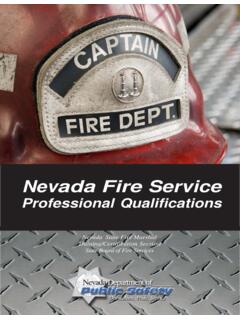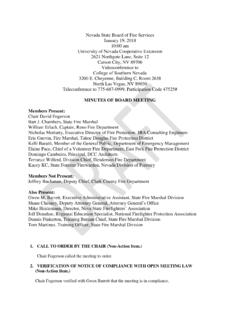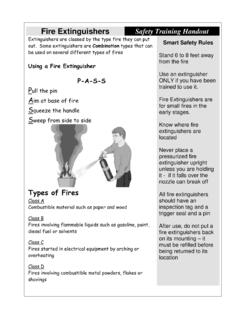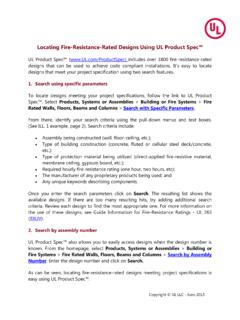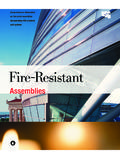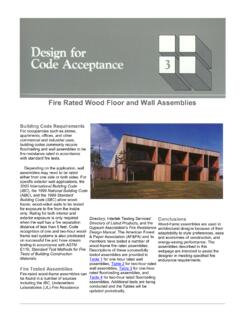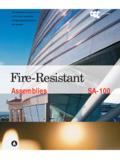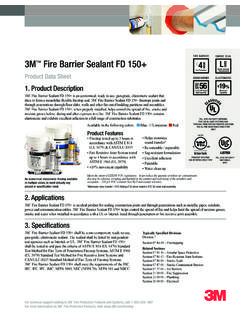Transcription of BUILDING CONSTRUCTION AND OCCUPANCY TYPES - Fire …
1 INTRODUCTION TO fire INSPECTION PRINCIPLES AND PRACTICES BUILDING CONSTRUCTION AND OCCUPANCY TYPES TERMINAL OBJECTIVES The students will be able to: 1. Identify basic TYPES of CONSTRUCTION . 2. Identify BUILDING subsystems and their functions. 3. Identify different classifications of OCCUPANCY . ENABLING OBJECTIVES The students will: 1. Identify the TYPES of buildings that contain the CONSTRUCTION TYPES . 2. Identify the TYPES of BUILDING subsystems. 3. Define OCCUPANCY TYPES . BUILDING CONSTRUCTION AND OCCUPANCY TYPES SM BC-2 BUILDING CONSTRUCTION AND OCCUPANCY TYPES RELATIONSHIP BETWEEN BUILDING CONSTRUCTION AND fire Having briefly examined some of the more common hazards the inspector is likely to face, it is now time to take a look at a related aspect: the constructions that often house many of these very hazards. Somewhat like the hazards themselves, these structures present risks to life and safety.
2 The CONSTRUCTION of a BUILDING plays a critical role in the prevention process. The following example probably will not create a lot of controversy. A 50-year-old wooden barn 2 miles from the nearest water supply poses a much greater fire risk than a 1-year-old fire - resistive BUILDING equipped with state-of-the-art alarm and sprinkler systems. While this is a rather obvious example, it illustrates a key point: the BUILDING 's CONSTRUCTION and systems either help prevent fires or "help" fires spread once they start. This module will look at some basic CONSTRUCTION TYPES and their features as these affect the job of the inspector. As has been stated already, this brief overview is just a start. A good inspector, like every other "good" professional, never stops learning. fire Spread At the turn of the century, conflagrations were a common occurrence. Increased knowledge of fire behavior and BUILDING design helped to confine fires to the BUILDING of origin.
3 Recent developments have led to fire -safe designs which confine the fire to the room or floor of origin. At present, technology can limit fires to an even smaller area, and possibly to the object of fire origin within a room. fire -Safe Design The objectives of fire -safe design in BUILDING CONSTRUCTION are life safety, property protection, and the continuation of the BUILDING in its intended use. The first step is to identify the occupant characteristics of the BUILDING . A design for fire safety may include various options. Evacuating occupants. This depends on both the availability of a path of escape and alerting the occupants. SM BC-3 BUILDING CONSTRUCTION AND OCCUPANCY TYPES Defending the occupants in place. This is used when evacuation has an unacceptable likelihood of success. Providing an effective area of refuge. This involves movement through the BUILDING to a safe area. CLASSIFICATIONS OF BUILDING CONSTRUCTION The model BUILDING codes and NFPA 220, Standard on TYPES of BUILDING CONSTRUCTION , provide five major TYPES of BUILDING CONSTRUCTION classifications.
4 Noncombustible Protected (Type I) In this type of CONSTRUCTION the structural elements consist of noncombustible materials, usually steel or concrete, that afford a fire resistance rating that provides a given fire protection performance endurance against the effects of fire . These specific ratings are determined by the model BUILDING codes for a specific type of CONSTRUCTION . These specific ratings apply to the roof and floor assemblies as well as any exterior or interior bearing support walls. Interior partitions are required to be constructed with approved noncombustible materials. The fire resistance ratings are provided by different designs that meet minimum performances. Encasement with Concrete Encasement with Gypsum Board Spray-on applied Coating Figure 1 Examples of fire Resistance Design Methods SM BC-4 BUILDING CONSTRUCTION AND OCCUPANCY TYPES Structural elements are entirely of noncombustible or limited combustible materials.
5 Totally noncombustible refers only to structural materials, not to interior finish and contents. Wall enclosures may be masonry, steel, aluminum, glass, or other material. Once wall coverings are in place, it may be difficult to determine if structural elements are exposed or protected. Noncombustible Unprotected (Type II) The same requirements that apply to noncombustible Type I CONSTRUCTION also apply to this type of CONSTRUCTION , with one basic difference. This type of CONSTRUCTION may not afford any fire -resistance rating for the exposed structural elements. If any fire protection of the structural elements is provided, it is at a lesser rating than that required for Type I CONSTRUCTION . In this type of BUILDING the structural elements are usually made of steel, bolted, riveted, or welded together. This type of CONSTRUCTION is susceptible to expansion, distortion, or relaxation of the steel members, resulting in early collapse during a fire .
6 Again, interior partitions are required to be constructed with noncombustible or approved limited combustible materials. Figure 2 Noncombustible Unprotected Combustible/Noncombustible (Type III) In this CONSTRUCTION type all or part of the interior structural elements may be combustible. Exterior walls are required to be constructed with noncombustible materials. They can have a fire -resistance rating, depending upon the horizontal separation and whether they are bearing or nonbearing walls. This category usually is divided into protected and unprotected subtypes. The BUILDING will have masonry exterior walls (usually brick), and wooden structural members and combustible interior CONSTRUCTION . The BUILDING generally will not exceed six stories, and most often will be two or three stories in height; it is often called "Main Street SM BC-5 BUILDING CONSTRUCTION AND OCCUPANCY TYPES USA." Floor and roof supports are usually wood, but other materials, such as steel bar joists, may be found.
7 Floor and roof decking most frequently will be plywood or composition board. Common walls between buildings may share wall sockets for floor joists and roof rafters. This type of CONSTRUCTION was originally referred to as ordinary. This occurs with solid masonry bearing walls. The floor or roof members are wood. It uses a fire -cut joist. Figure 3 Combustible/Noncombustible Heavy Timber (Type IV) Heavy timber structural members--columns, beams, arches, floors, and roofs--are unprotected wood with large cross-sectional areas. A minimum dimension of eight inches for structural wood supports (columns, beams, arches, and girders) is required. All other exposed wood must have a minimum dimension of two inches. Concealed spaces usually are not permitted. These buildings consist of masonry (noncombustible) exterior walls and structural members of substantial timber CONSTRUCTION . Commonly this type of CONSTRUCTION is found in older factories and mills.
8 Wood floors generally will have a minimum thickness of three inches and may be oil-soaked from years of oiling heavy machinery with lubricating oils. Roof supports will be wood with minimum dimensions of four by six inches, and a minimum roof decking thickness of 1-1/8 inches. SM BC-6 BUILDING CONSTRUCTION AND OCCUPANCY TYPES This is often laminated or solid wood beams. Figure 4 Heavy Timber Combustible (Type V) This type of CONSTRUCTION uses structural members entirely of combustible materials, usually wood, and is divided into two subgroups: protected--structural elements protected as required; or unprotected--no fire resistance requirement. Walls, floors, and roof structure are usually wood frame using different CONSTRUCTION methods. Post-and-beam CONSTRUCTION has a wood frame of substantial dimension and is sided with a lightweight covering such as wood boards, or plywood covered with aluminum or PVC siding.
9 This type of CONSTRUCTION is commonly used for barns, sheds, and other storage buildings but also may occur in dwellings and other occupancies. In balloon frame CONSTRUCTION , studs run from the foundation to the attic. This type of CONSTRUCTION was common in many parts of the country until the late 1930s for residential and light commercial buildings. This provides a continuous air space from top to bottom. Floor joists are tied into the wall, allowing for fire extension in any direction. Firestopping was not a common practice. In platform frame CONSTRUCTION the walls of each successive story are built on a platform formed by the preceding floor. The joists for the deck may be full-dimension lumber or lightweight materials. Once the floor or SM BC-7 BUILDING CONSTRUCTION AND OCCUPANCY TYPES deck is in place, walls are placed on it with a sill at the bottom of the wall and a plate at the top. Platform frame CONSTRUCTION provides a natural fire barrier for vertical extension within the walls, but openings in walls for water, sewer, ventilation, or heating/air conditioning pipes can create a void for fire extension.
10 This type may or may not have veneer finish. Figure 5 Combustible (Frame) BUILDING SUBSYSTEMS BUILDING subsystems provide for the practical use of a structure. These components include electrical, heating, ventilating, and air conditioning (HVAC), plumbing, and transportation. A basic knowledge of these subsystems and their relationship to the structure helps to understand how they may affect fire safety. These subsystems may be considered separately, but it must be understood that each subsystem is only one part of the total BUILDING system. Electrical Systems If properly designed, installed, and maintained, electrical systems are both convenient and safe; otherwise they may cause both fire and injury. When an electric circuit carrying current is interrupted intentionally or unintentionally, arcing or heating results. fire protection standards are requirements intended to prevent arcing and overheating or accidental contact, which may cause electric shock.

